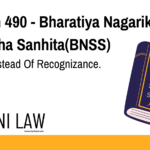Code: Section 497 BNSS
(1) When any property is produced before any Criminal Court or the Magistrate
empowered to take cognizance or commit the case for trial during any investigation, inquiry
or trial, the Court or the Magistrate may make such order as it thinks fit for the proper
custody of such property pending the conclusion of the investigation, inquiry or trial, and,
if the property is subject to speedy and natural decay, or if it is otherwise expedient so to do,
the Court or the Magistrate may, after recording such evidence as it thinks necessary, order
it to be sold or otherwise disposed of.
Explanation.—For the purposes of this section, “property” includes—
(a) property of any kind or document which is produced before the Court or
which is in its custody;
(b) any property regarding which an offence appears to have been committed
or which appears to have been used for the commission of any offence.
(2) The Court or the Magistrate shall, within a period of fourteen days from the
production of the property referred to in sub-section (1) before it, prepare a statement of
such property containing its description in such form and manner as the State Government
may, by rules, provide.
(3) The Court or the Magistrate shall cause to be taken the photograph and if necessary,
videograph on mobile phone or any electronic media, of the property referred to in
sub-section (1).
(4) The statement prepared under sub-section (2) and the photograph or the
videography taken under sub-section (3) shall be used as evidence in any inquiry, trial or
other proceeding under the Sanhita.
(5) The Court or the Magistrate shall, within a period of thirty days after the statement
has been prepared under sub-section (2) and the photograph or the videography has been
taken under sub-section (3), order the disposal, destruction, confiscation or delivery of the
property in the manner specified hereinafter.
Explanation of Section 497 BNSS
Section 497 of the BNSS governs the procedure for the handling and disposal of property produced before a Court or Magistrate during an investigation, inquiry, or trial. The Court or Magistrate has the authority to make orders regarding the custody of the property, and if the property is perishable or subject to decay, it may be disposed of following the due process.
Key Points:
- Property Custody: The Court or Magistrate ensures proper custody of property until the case is concluded.
- Perishable Property: If the property is likely to decay, the Court can order it to be sold or disposed of.
- Property Description: A statement of the property must be prepared within 14 days, describing it according to the rules set by the State Government.
- Documentation: The property must be photographed or videographed as evidence, which will be used in subsequent legal proceedings.
- Final Disposal: The Court or Magistrate must decide on the final disposal, destruction, or confiscation of the property within 30 days.
Illustration
Example 1: Property Being Sold Due to Decay
A large quantity of fruits and vegetables is produced before the Court during a criminal trial. The Court determines that the property is perishable and, after proper documentation and evidence, orders the sale of the goods to prevent further loss.
Example 2: Videographing the Property for Evidence
During an investigation, a firearm is produced as evidence. The Magistrate ensures that the firearm is photographed and videographed to record its condition for use in the trial.
Example 3: Disposal of Stolen Goods
A case involves stolen jewelry as evidence. After completing the necessary documentation and ensuring that the jewelry is photographed, the Magistrate orders its confiscation or return to the rightful owner within the prescribed time frame.
Common Questions and Answers on Section 497 BNSS
1. What does “property” mean in Section 497 BNSS?
- Answer: “Property” in this section refers to any items, documents, or things produced before the Court, which may be part of an investigation, inquiry, or trial. This includes property that has been used in the commission of a crime or is suspected to be involved.
2. What happens if the property produced before the Court is perishable?
- Answer: If the property is subject to speedy decay, the Court or Magistrate may order it to be sold or disposed of after recording necessary evidence.
3. How does the Court ensure the property is documented properly?
- Answer: The Court or Magistrate must prepare a detailed statement of the property, including descriptions, and take photographs or videos to document its condition.
4. Can the property be disposed of immediately after being produced?
- Answer: No, the Court or Magistrate must first prepare the statement, take photographs or videography, and follow the procedures outlined in the law before ordering the disposal, destruction, or return of the property.
Conclusion
Section 497 of the BNSS ensures that property presented in criminal cases is properly handled and documented. It outlines a clear procedure for dealing with property that may be perishable or used in the commission of a crime, providing transparency and accountability in how evidence is managed during a trial.











